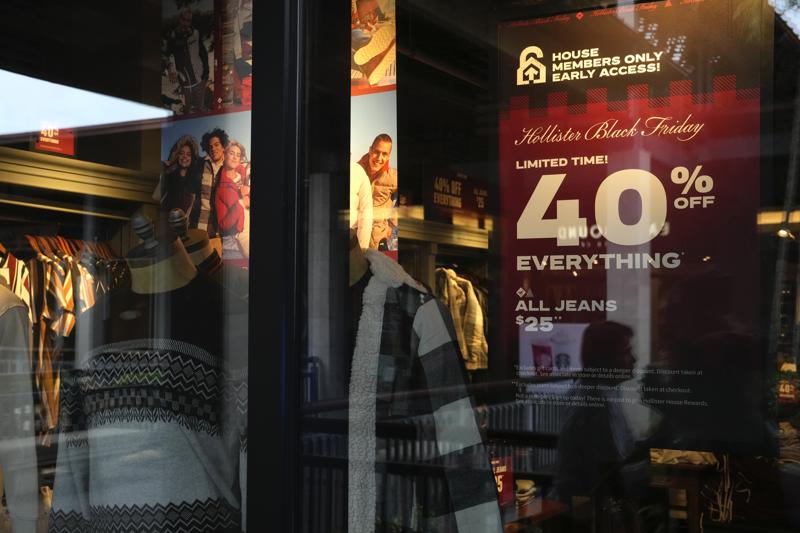
Shoppers returned to familiar holiday shopping patterns but were weighed down by inflation this Black Friday after two seasons marked by pandemic worries and supply issues.
Due to elevated prices for food, rent, gasoline and other household costs, many were reluctant to spend unless there was a big sale.
Shoppers were being more selective, selecting cheaper options, dipping more into savings and turning to “buy now, pay later” services that allow payment in installments. Some were also running up their credit cards at a time when the Federal Reserve is hiking rates to cool the U.S. economy.
Financial hardships were driving shoppers to look for bargains.
Macy’s Herald Square in Manhattan, where discounts included 60% off fashion jewelry and 50% off select shoes, was bustling with shoppers early Friday.
The traffic was “significantly larger” on Black Friday compared to the previous two years because shoppers feel more comfortable in crowds, Macy’s CEO Jeff Gennette said.
He said that bestsellers from Macy’s online sale, which started last weekend, included 50% off beauty sets. Last year Macy’s, like many other stores, had supply chain issues and some of the gifts didn’t arrive until after Christmas.
“Right now we are set and ready to go, “ he said.
Sophia Rose, 40, a respiratory specialist visiting Manhattan from Albany, New York, was heading into Macy’s with big plans to splurge after scrimping last year when she was still in school. She put herself on a budget for food and gas to cope with inflation but had already spent $2,000 for holiday gifts, and plans to spend a total of $6,000.
“I am going to touch every floor,” she said. “That’s the plan.”
This year’s trends are a contrast from a year ago when consumers were buying early out of fear of not getting what they needed amid supply-network clogs. Stores didn’t have to discount much because they were struggling to bring in items.
But some pandemic habits are sticking around. Many retailers that closed stores on Thanksgiving Day, and instead pushed discounts on their websites to thin out crowds at stores, are still holding on to those strategies, despite a return to normalcy.
Major retailers including Walmart and Target again closed their stores on Thanksgiving. And many moved away from doorbusters, the deeply marked-down items offered for a limited time that drew crowds. Instead, the discounted items are available throughout the month, on Black Friday or the holiday weekend.
Against today’s economic backdrop, the National Retail Federation — the largest retail trade group — expects holiday sales growth will slow to a range of 6% to 8%, from the blistering 13.5% growth of a year ago. However, these figures, which include online spending, aren’t adjusted for inflation, so real spending could even be down from a year ago.
Adobe Analytics expects online sales to be up 2.5% from Nov. 1 through Dec. 31, a slowdown from the 8.6% pace last year, when shoppers were uncertain about returning to physical stores.
Isela Dalencia, who was shopping for household essentials like detergent at a Walmart in Secaucus, New Jersey, this week, said she’s delaying buying holiday gifts until Cyber Monday — the Monday after Thanksgiving — when online sales rev up. Then, she will wait again until the week before Christmas to get the best deals, unlike last year when she started buying before Black Friday.
“I am shopping less,” Dalencia said, noting she will spend about $700 for holiday gifts this year, one-third less than last year.
Katie Leach, a social worker in Manhattan, was also browsing the aisles at Walmart but said she will start holiday shopping during the first week of December as usual. This time, however, she’ll be relying more on bargains, her credit card and “buy now, pay later” services to get her through the shopping season because of surging prices on food and other household expenses.
“The money is not going as far as last year,” Leach said.
Analysts consider the five-day Black Friday weekend, which includes Cyber Monday, a key barometer of shoppers’ willingness to spend, particularly this year. The two-month period between Thanksgiving and Christmas represents about 20% of the retail industry’s annual sales.
_____
Republished with permission of The Associated Press.



7 comments
Bye Nancy
November 25, 2022 at 3:40 pm
Well you dummies appear to be satisfied with inflation, fuel prices, border chaos, and police defunding. You also vote for mental incompetence like Fetterman and Biden. Well at least the “wicked witch of the west” is out of power. Hopefully some of you Demo zombies will wake up in 2024.
Joe Corsin
November 25, 2022 at 9:01 pm
My peepee itches. Please help
Elliott Offen
November 25, 2022 at 9:05 pm
Stop pretending to be me! YOU ARE CLEARLY FAKE TOM! Leave me and my alternate personalities alone. If you keep this up the head doctor will put in the straightjacket again.
Ocean Joe
November 25, 2022 at 9:13 pm
The precious. The precious. They will never take our precious from us. They will never take our precious computer.
Tom
November 25, 2022 at 9:41 pm
It’s always bout the children, the children, oh the children, says Nancy Delasandro Pelosi.
Thank God she gone!
Joe Corsin
November 26, 2022 at 11:47 am
Quick replay and persistent on-line interest helped me routinely produce more than $26,300 in additional domestic revenue. My actual earnings with my highest kmo domestic sales were $18,636. Certainly, everyone can now.
…
Utilize to increase your online income—————————->>>
Tom
November 25, 2022 at 9:41 pm
It’s always bout the children, the children, oh the children, says Nancy Delasandro Pelosi.
Thank God she gone!
Comments are closed.